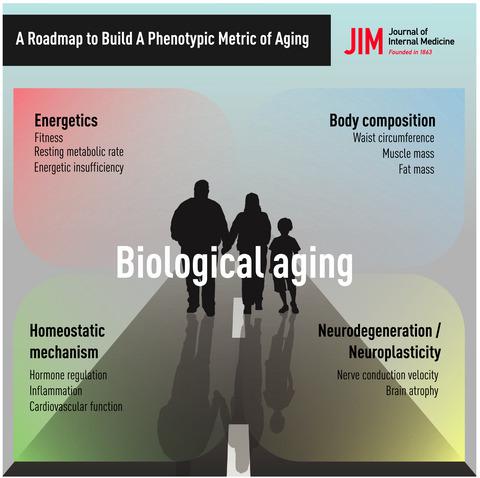当前位置:
X-MOL 学术
›
J. Intern. Med.
›
论文详情
Our official English website, www.x-mol.net, welcomes your
feedback! (Note: you will need to create a separate account there.)
A roadmap to build a phenotypic metric of ageing: insights from the Baltimore Longitudinal Study of Aging.
Journal of Internal Medicine ( IF 9.0 ) Pub Date : 2020-02-27 , DOI: 10.1111/joim.13024 P-L Kuo 1, 2 , J A Schrack 1, 2 , M D Shardell 1 , M Levine 3 , A Z Moore 1 , Y An 4 , P Elango 1 , A Karikkineth 5 , T Tanaka 1 , R de Cabo 1 , L M Zukley 5 , M AlGhatrif 1, 6 , C W Chia 7 , E M Simonsick 1 , J M Egan 7 , S M Resnick 4 , L Ferrucci 1
Journal of Internal Medicine ( IF 9.0 ) Pub Date : 2020-02-27 , DOI: 10.1111/joim.13024 P-L Kuo 1, 2 , J A Schrack 1, 2 , M D Shardell 1 , M Levine 3 , A Z Moore 1 , Y An 4 , P Elango 1 , A Karikkineth 5 , T Tanaka 1 , R de Cabo 1 , L M Zukley 5 , M AlGhatrif 1, 6 , C W Chia 7 , E M Simonsick 1 , J M Egan 7 , S M Resnick 4 , L Ferrucci 1
Affiliation

|
Over the past three decades, considerable effort has been dedicated to quantifying the pace of ageing yet identifying the most essential metrics of ageing remains challenging due to lack of comprehensive measurements and heterogeneity of the ageing processes. Most of the previously proposed metrics of ageing have been emerged from cross-sectional associations with chronological age and predictive accuracy of mortality, thus lacking a conceptual model of functional or phenotypic domains. Further, such models may be biased by selective attrition and are unable to address underlying biological constructs contributing to functional markers of age-related decline. Using longitudinal data from the Baltimore Longitudinal Study of Aging (BLSA), we propose a conceptual framework to identify metrics of ageing that may capture the hierarchical and temporal relationships between functional ageing, phenotypic ageing and biological ageing based on four hypothesized domains: body composition, energy regulation, homeostatic mechanisms and neurodegeneration/neuroplasticity. We explored the longitudinal trajectories of key variables within these phenotypes using linear mixed-effects models and more than 10 years of data. Understanding the longitudinal trajectories across these domains in the BLSA provides a reference for researchers, informs future refinement of the phenotypic ageing framework and establishes a solid foundation for future models of biological ageing.
中文翻译:

建立衰老表型指标的路线图:来自巴尔的摩衰老纵向研究的见解。
在过去的三十年里,人们在量化老龄化速度方面付出了相当大的努力,但由于缺乏全面的测量和老龄化过程的异质性,确定最重要的老龄化指标仍然具有挑战性。大多数先前提出的衰老指标都是从与实际年龄和死亡率预测准确性的横截面关联中得出的,因此缺乏功能或表型域的概念模型。此外,这些模型可能会因选择性减员而产生偏差,并且无法解决导致与年龄相关的衰退的功能标志物的潜在生物学结构。使用来自巴尔的摩老龄化纵向研究 (BLSA) 的纵向数据,我们提出了一个概念框架来确定衰老指标,该指标可以基于四个假设领域:身体成分、能量调节、稳态机制和神经退行性/神经可塑性来捕捉功能性衰老、表型衰老和生物衰老之间的层次和时间关系。我们使用线性混合效应模型和超过 10 年的数据探索了这些表型中关键变量的纵向轨迹。了解 BLSA 中这些领域的纵向轨迹为研究人员提供了参考,为未来表型衰老框架的改进提供了信息,并为未来的生物衰老模型奠定了坚实的基础。能量调节、稳态机制和神经变性/神经可塑性。我们使用线性混合效应模型和超过 10 年的数据探索了这些表型中关键变量的纵向轨迹。了解 BLSA 中这些领域的纵向轨迹为研究人员提供了参考,为未来表型衰老框架的改进提供了信息,并为未来的生物衰老模型奠定了坚实的基础。能量调节、稳态机制和神经变性/神经可塑性。我们使用线性混合效应模型和超过 10 年的数据探索了这些表型中关键变量的纵向轨迹。了解 BLSA 中这些领域的纵向轨迹为研究人员提供了参考,为未来表型衰老框架的改进提供了信息,并为未来的生物衰老模型奠定了坚实的基础。
更新日期:2020-02-27
中文翻译:

建立衰老表型指标的路线图:来自巴尔的摩衰老纵向研究的见解。
在过去的三十年里,人们在量化老龄化速度方面付出了相当大的努力,但由于缺乏全面的测量和老龄化过程的异质性,确定最重要的老龄化指标仍然具有挑战性。大多数先前提出的衰老指标都是从与实际年龄和死亡率预测准确性的横截面关联中得出的,因此缺乏功能或表型域的概念模型。此外,这些模型可能会因选择性减员而产生偏差,并且无法解决导致与年龄相关的衰退的功能标志物的潜在生物学结构。使用来自巴尔的摩老龄化纵向研究 (BLSA) 的纵向数据,我们提出了一个概念框架来确定衰老指标,该指标可以基于四个假设领域:身体成分、能量调节、稳态机制和神经退行性/神经可塑性来捕捉功能性衰老、表型衰老和生物衰老之间的层次和时间关系。我们使用线性混合效应模型和超过 10 年的数据探索了这些表型中关键变量的纵向轨迹。了解 BLSA 中这些领域的纵向轨迹为研究人员提供了参考,为未来表型衰老框架的改进提供了信息,并为未来的生物衰老模型奠定了坚实的基础。能量调节、稳态机制和神经变性/神经可塑性。我们使用线性混合效应模型和超过 10 年的数据探索了这些表型中关键变量的纵向轨迹。了解 BLSA 中这些领域的纵向轨迹为研究人员提供了参考,为未来表型衰老框架的改进提供了信息,并为未来的生物衰老模型奠定了坚实的基础。能量调节、稳态机制和神经变性/神经可塑性。我们使用线性混合效应模型和超过 10 年的数据探索了这些表型中关键变量的纵向轨迹。了解 BLSA 中这些领域的纵向轨迹为研究人员提供了参考,为未来表型衰老框架的改进提供了信息,并为未来的生物衰老模型奠定了坚实的基础。











































 京公网安备 11010802027423号
京公网安备 11010802027423号